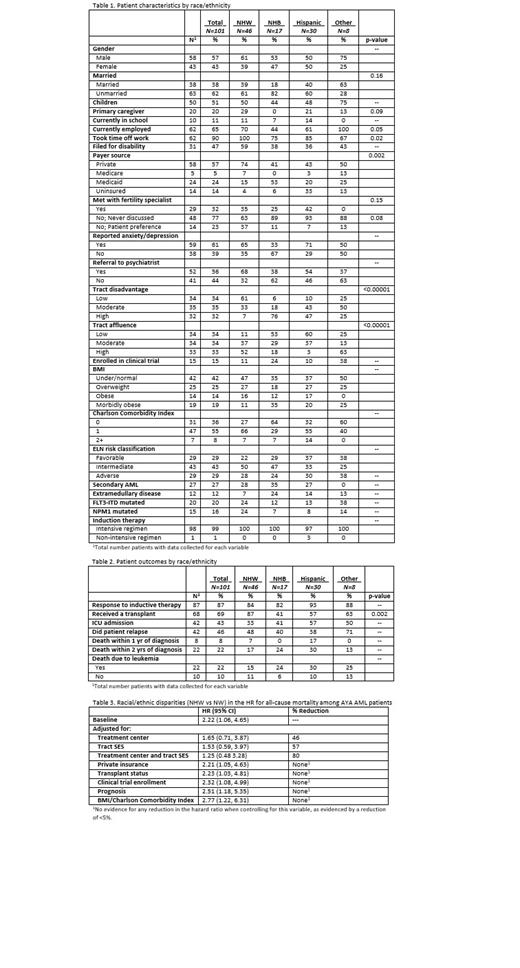Abstract
Introduction
AYA cancer patients (pts) face unique healthcare disparities due to their social development stage. AYA with AML and minorities continue to suffer reduced survival (Kahn, Cancer, 2016). Our group demonstrated that structural violence, specifically neighborhood socioeconomic status (SES), significantly impacts adult AML survival (Abraham, Blood, 2020). This real-world study, in a segregated metropolitan area, confirms inferior survival in the non-white (NW) AYA AML population and explores social barriers that contribute to disparities.
Methods
AYA AML (non-APL) pts, age 18 to 39, diagnosed and treated between 2012- 2018 at 6 cancer centers across the Chicago area were included. Race/ethnicity was categorized as Non-Hispanic White (NHW), Hispanic, non-Hispanic Black (NHB), and Other. Census tract data was collected using the FFIEC Geocoding/Mapping System and computed tract disadvantage and affluence scores, divided into high, moderate, and low tertiles. A survival analysis was performed to generate hazard ratios (HR) for all-cause mortality between NHW and NW pts. Social determinants of health explored for AYA outcomes included caregiver responsibilities, employment, time off work, mental health, Charlson Comorbidity Index (CCI) and obesity.
Results
Table 1 shows demographic data (n=101); 46% were NHW, 17% were NHB, 30% were Hispanic, and 8% were other. Median age was 31 years. The number of pts with children was similar across all groups, while more NHW (29%) and Hispanic (21%) pts reported being caregivers to other household members compared to NHB pts (0%), despite their young age (p=0.09). Overall, 68% of pts never met with a fertility specialist, more frequently due to no counseling (77%) than patient preference (23%). Most pts were not in school during treatment. NHW pts took time off work and filed for disability more commonly than NHB and Hispanic pts. NHW (65%) and Hispanic (71%) pts both reported anxiety and/or depression during treatment more than NHB pts (33%). Yet, NHW pts (68%) were referred to psychiatry more often than Hispanic pts (54%).
Payer source differed significantly. Most NHW pts had private insurance, unlike NHB and Hispanic pts (74% vs. 41% vs. 43% respectively). The largest uninsured population was Hispanic (33%) compared to NHW (4%) and NHB (6%) pts. NHB pts (76%) tended to reside in more disadvantaged areas, while Hispanics (60%) tended to live in less affluent areas.
ELN classification was comparable amongst NHW and NHB pts, while the largest group of favorable risk pts were Hispanic (37%). Extramedullary disease was more frequent in NHB (25%) and Hispanic (14%) compared to NHW (7%) pts. FLT3-ITD mutations and NPM1 mutations were more prevalent in NHW pts. Molecular testing was not done on most pts.
Overall, 87% achieved CR/CRi. Notably, ICU stays during or post induction were higher in NHB (41%) and Hispanic (57%) compared to in NHW (33%) pts. Transplant status differed significantly with 87% of NHW pts receiving a transplant compared to NHB (41%) and Hispanic (57%) pts. Relapse rates were similar between all groups. However, the incidence of death within 2 years of diagnosis was highest in NHB (24%) and Hispanic (30%) pts, and nearly half that in the NHW pts (17%). (Table 2)
32 pts died, 22 due to leukemia. Hazard of all-cause mortality was over twice as great for NW than for NHW pts HR=2.22 (95% CI:1.06, 4.65). Statistical adjustment for tract SES accounted for 57% of the survival disparity, reducing the HR to 1.53 (95% CI:0.59, 3.87). Further adjustment for treatment center reduced the HR to 1.25 (95% CI: 0.48, 3.28); together, treatment center and tract SES accounted for 80% of the survival disparity. Adjustment for private insurance, transplant status, clinical trial enrollment, prognosis (based on ELN classification and secondary AML) and BMI/CCI did not appear to account for any of the survival disparity. (Table 3)
Conclusion
Our study shows that Hispanic and NHB AYA AML pts have inferior survival compared to NHW pts despite similar ELN risk groups, treatment, response and relapse rates. Census tract-level SES related to differential resources in neighborhoods explained a significant proportion of the disparity in hazard of all-cause mortality. Our work highlights social determinants of health in AYA leukemia pts must be elucidated to determine mechanisms underlying structural barriers and inform future interventions to mitigate survival disparities.
Patel: Pfizer: Research Funding; Celgene/BMS: Research Funding. Stock: Pfizer: Consultancy, Honoraria, Research Funding; amgen: Honoraria; agios: Honoraria; jazz: Honoraria; kura: Honoraria; kite: Honoraria; morphosys: Honoraria; servier: Honoraria; syndax: Consultancy, Honoraria; Pluristeem: Consultancy, Honoraria. Altman: Theradex: Consultancy; Syros: Consultancy; Kuro Oncology: Consultancy; Daiichi Sankyo: Consultancy; Astellas: Consultancy; AbbVie: Consultancy; Glycomimetics: Membership on an entity's Board of Directors or advisory committees; BioSight: Consultancy, Other: Travel fees to attend an advisory meeting (I did not accept payment for the advisory board). Dinner: Kite/Gilead: Consultancy, Honoraria; Pfizer: Consultancy, Honoraria.


